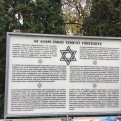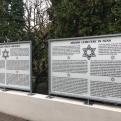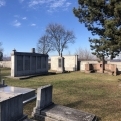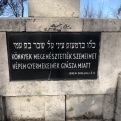Az avasi zsidó temető története - Holokauszt emlékmű
Település:
Miskolc, Magyarország
Cím:
3501 Miskolc, Mendikás dűlő
Állította:
Miskolci Zsidó Hitközség, 1970
Könnyek megemésztették szemeimet népem gyermekeinek gyásza miatt







Az emlékmű története
A zsidók megjelenése Magyarországon a 18. században kezdődött meg.
Az ide letelepülő zsidóság nagyrésze kisiparosok, illetve házaló
kereskedők voltak. A század közepére már 24 család költözött a
megyeszékhelyre, Miskolcra. Mivel ilyen nagy számban voltak már jelen,
így rabbik és tanárok is megjelentek a városban. A 18. század végére már
több száz zsidónak a jelenléte volt fellelhető.
A
családok gyors betelepülésének egyik nagy hatása a városra a zsidó
temető kialakítása volt. Ennek következtében a temető mai helyének
megvásárlására 1759-ben került sor az Avas északnyugati oldalán.
Valószínűleg a városgazda azért vált meg mondhatni könnyen ettől a
területtől, mert terméketlen lehetett vagy pedig pincék kialakításának
nem felelhetett meg. 55 évre a temető megvásárlása után, azaz 1814-ben
történt meg a terület körülkerítése, egy ónodi zsidó lakos, Klein
Salamon anyagi támogatásának köszönhetően. Salamon egész vagyonát
áldozta arra, hogy ez az 5 hektár és 34 négyzetméteres terület
biztonságban legyen. „Az összes költség 20 ezer forintot tett ki”.
A
temetőnek két főbejáratot alakítottak ki, egyik az Avas tetején, míg a
másik a Ruzsin felőli oldalon volt, mivel a feljárás és megközelítés
innen volt csak lehetséges. Az alsó rész bejárata mellé építettek egy
szertartási épületet, amelyet csak nagyon ritka esetben használtak.
1987-ben a temető kerítésének megújítására került sor. Ennek hatására a
szertartási épület maradványait lebontották, és ezzel párhuzamosan
megszüntették mind a két bejáratot is. Ezt követően még két bejáratot
építettek ki, az egyiket a keleti oldalon az őrház mellett, amely a mai
Avastetőnél található, valamint a déli oldalon, amely a mai Avas
feljáróút mellé esik, és az előbbi lett a főbejárat. A keleti oldalú
bejárathoz lettek elhelyezve a rituális kellékek is, másnéven a kijor,
amely magába foglalja a kézmosótálat, vízmérő edényt.
A
halotti szertartások kezdete a főbejáraton, vagyis a déli kapun
kezdődik. A temetés során a hagyományoknak megfelelően, a gyászmenetet
az elhunyt gyászolói kísérik, a rabbi illetve a kántor vezetésével. Az
út során többször megállnak imát mondani. A gyászolók külön csoportokban
vannak, az egyiket nők, míg a másikat férfiak alkotják. A halott
eltemetésének szertartása után a keleti kapun hagyják el a gyászolók a
temetőt.A temetőnek szigorú előírásai vannak a
sírokra vonatkoztatva: minden sírnak 6 férfi arasznyira kell egymástól
lennie. Nőket és férfiakat általában külön temették (kivételes eset a
házasság) és közéjük kis ösvényt helyeztek, jelezvén a határt. Viszont a
helyhiány miatt gyakran keveredtek a különböző nemek sírjai egymással. A
zsidó törvényeknek megfelelően a sírok örökre szólnak. A sírköveket
tekintve mind kelet felé néznek, és a holtak testét tartalmazó koporsót
is úgy helyezték el, hogy keleti irányba legyenek. A sírkövek között
nagy különbség nincs, hiszen a környező kavicsbányákból származó
anyagokat használták fel, mint például bükkábrányi, bodrogkeresztúri
kövek.
A zsidó temető szent egylete, melynek
megnevezése a Chevra Kadisha (arámi:חֶבְרָה קַדִישָא, Ḥebhra Qaddisha),
amely 1769-ben lett megalapítva Miskolcon. A zsidóság egyik legősibb
intézménye, amely nőkből és férfiakból egyaránt áll. Feladatuk hogy az
elhunytak a zsidó hagyományoknak megfelelően legyenek eltemetve.
Továbbá felel a hagyományok és szertartások ősi, pontos betartásáért is,
melynek működését a Sulchan Áruh, azaz a középkori törvénytár
szabályozza. Chevra nélkülözése zsidó közösségben lehetetlen, hiszen
nélküle a közösség nem működne. Az egylet tagjai kinevezésüket követően
ünnepélyes fogadalmat tesznek a rituális szabályok betartására, illetve a
tevékenységüket a Chevra-könyvben rögzítik.
A zsidók megjelenése Magyarországon a 18. században kezdődött meg.
Az ide letelepülő zsidóság nagyrésze kisiparosok, illetve házaló
kereskedők voltak. A század közepére már 24 család költözött a
megyeszékhelyre, Miskolcra. Mivel ilyen nagy számban voltak már jelen,
így rabbik és tanárok is megjelentek a városban. A 18. század végére már
több száz zsidónak a jelenléte volt fellelhető.
A
családok gyors betelepülésének egyik nagy hatása a városra a zsidó
temető kialakítása volt. Ennek következtében a temető mai helyének
megvásárlására 1759-ben került sor az Avas északnyugati oldalán.
Valószínűleg a városgazda azért vált meg mondhatni könnyen ettől a
területtől, mert terméketlen lehetett vagy pedig pincék kialakításának
nem felelhetett meg. 55 évre a temető megvásárlása után, azaz 1814-ben
történt meg a terület körülkerítése, egy ónodi zsidó lakos, Klein
Salamon anyagi támogatásának köszönhetően. Salamon egész vagyonát
áldozta arra, hogy ez az 5 hektár és 34 négyzetméteres terület
biztonságban legyen. „Az összes költség 20 ezer forintot tett ki”.
A
temetőnek két főbejáratot alakítottak ki, egyik az Avas tetején, míg a
másik a Ruzsin felőli oldalon volt, mivel a feljárás és megközelítés
innen volt csak lehetséges. Az alsó rész bejárata mellé építettek egy
szertartási épületet, amelyet csak nagyon ritka esetben használtak.
1987-ben a temető kerítésének megújítására került sor. Ennek hatására a
szertartási épület maradványait lebontották, és ezzel párhuzamosan
megszüntették mind a két bejáratot is. Ezt követően még két bejáratot
építettek ki, az egyiket a keleti oldalon az őrház mellett, amely a mai
Avastetőnél található, valamint a déli oldalon, amely a mai Avas
feljáróút mellé esik, és az előbbi lett a főbejárat. A keleti oldalú
bejárathoz lettek elhelyezve a rituális kellékek is, másnéven a kijor,
amely magába foglalja a kézmosótálat, vízmérő edényt.
A
halotti szertartások kezdete a főbejáraton, vagyis a déli kapun
kezdődik. A temetés során a hagyományoknak megfelelően, a gyászmenetet
az elhunyt gyászolói kísérik, a rabbi illetve a kántor vezetésével. Az
út során többször megállnak imát mondani. A gyászolók külön csoportokban
vannak, az egyiket nők, míg a másikat férfiak alkotják. A halott
eltemetésének szertartása után a keleti kapun hagyják el a gyászolók a
temetőt.A temetőnek szigorú előírásai vannak a
sírokra vonatkoztatva: minden sírnak 6 férfi arasznyira kell egymástól
lennie. Nőket és férfiakat általában külön temették (kivételes eset a
házasság) és közéjük kis ösvényt helyeztek, jelezvén a határt. Viszont a
helyhiány miatt gyakran keveredtek a különböző nemek sírjai egymással. A
zsidó törvényeknek megfelelően a sírok örökre szólnak. A sírköveket
tekintve mind kelet felé néznek, és a holtak testét tartalmazó koporsót
is úgy helyezték el, hogy keleti irányba legyenek. A sírkövek között
nagy különbség nincs, hiszen a környező kavicsbányákból származó
anyagokat használták fel, mint például bükkábrányi, bodrogkeresztúri
kövek.
A zsidó temető szent egylete, melynek
megnevezése a Chevra Kadisha (arámi:חֶבְרָה קַדִישָא, Ḥebhra Qaddisha),
amely 1769-ben lett megalapítva Miskolcon. A zsidóság egyik legősibb
intézménye, amely nőkből és férfiakból egyaránt áll. Feladatuk hogy az
elhunytak a zsidó hagyományoknak megfelelően legyenek eltemetve.
Továbbá felel a hagyományok és szertartások ősi, pontos betartásáért is,
melynek működését a Sulchan Áruh, azaz a középkori törvénytár
szabályozza. Chevra nélkülözése zsidó közösségben lehetetlen, hiszen
nélküle a közösség nem működne. Az egylet tagjai kinevezésüket követően
ünnepélyes fogadalmat tesznek a rituális szabályok betartására, illetve a
tevékenységüket a Chevra-könyvben rögzítik.
Akikre emlékezünk


Mordechai Yaakov Gottlieb Chaim
(1876-1936)
Égő gyertyák (0)
Kialudt gyertyák (0)






















